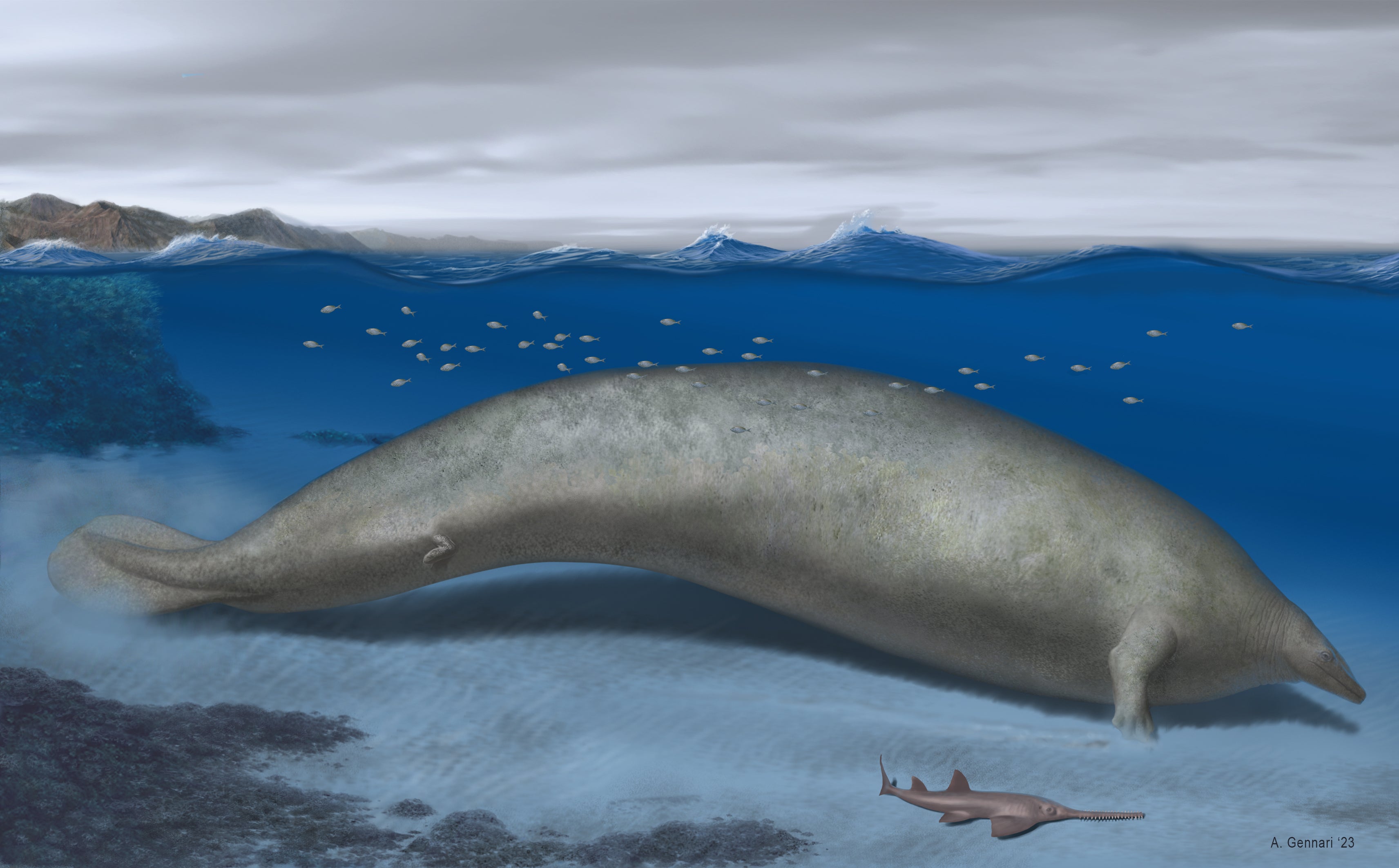
Scientists excavating in a Peruvian desert have found the fossilized bones of what they argue may have been the heaviest animal ever to live: a strange ancient whale that may have had a teensy head attached to a giant, bloated body.
The long-lost whale, now dubbed Perucetus colossus, had a skeleton that may have weighed two to three times that of a blue whale. Tipping the scales at up to 330,000 pounds, the blue whale is the heaviest animal alive today. Until now, paleontologists hadn’t found anything that could even compare to that behemoth.
“It’s an extraordinary claim—the heaviest animal yet described—so that requires pretty extraordinary evidence, and I think they convincingly demonstrated that,” says Annalisa Berta, a retired paleontologist and a professor emerita at San Diego State University, who was not involved in the new research. The study was published on August 2 in the journal Nature.
Paleontologist and study co-author Mario Urbina first stumbled on one of P. colossus’s vertebrae around a decade ago, says his colleague Rodolfo Salas-Gismondi, a paleontologist at Cayetano Heredia University in Peru, who is also a co-author of the paper. Urbina believed he’d found a fossil, but Salas-Gismondi wasn’t convinced. “I was skeptical about these fossils. I said to him, ‘It doesn’t look like real bone,’” Salas-Gismondi says, noting that the structure of the bone was very different from most finds. “It looked like a rock, in fact.”
But analyses showed that Urbina was correct. And since the initial find, the team has excavated 13 vertebrae, four ribs and part of a hip. The vertebrae are so weighty that the team could excavate only one or two each year, Salas-Gismondi says. “An animal of this size has never been found before in the fossil record anywhere in the world,” he says.
Other scientists agree that the bones are unprecedented. “It’s an astonishing specimen,” says Philip Gingerich, a paleontologist at the University of Michigan, who was not involved in the new research. “These vertebrae are nearly the size of beer kegs or something. They’re unlike anything certainly that I’ve ever seen—that anyone’s ever seen.”
As described by Salas-Gismondi and his colleagues, the fossils are extremely massive in two different ways. First, they are particularly dense. Bones usually have a spongy structure, but these have deposits filling those pores—hence his initial reaction that the vertebra fossil looked like a rock. Second, the bones are large and look like they’ve been inflated.
“It’s just incredibly bulbous,” says Emily Buchholtz, a paleontologist at Wellesley College, referring to a vertebra pictured in the paper. “I’ve never seen anything like it,” she adds, noting that blue whale vertebrae are also massive but sleek, whereas the bones of P. colossus are swollen.
Salas-Gismondi and his colleagues argue that the bones’ incredible mass represents an adaptation to coastal living in shallow waters. The dense bones, the researchers say, balanced the buoyancy of blubber and lungs filled with air—essentially they acted as ballast to let P. colossus whales remain underwater with less effort. “Scuba divers put on weight belts,” Berta says. “What these whales did was: they increased the density of their bones.”
The bones are nearly 40 million years old, which means the bizarre animal would have swam the seas just a couple of million years before primitive whales began their evolutionary split into the toothed and baleen whales we know today.
But scientists can’t know what P. colossus ate—or much else about how it lived—because they have only excavated the core of the body. “They’ve got the middle of the skeleton. I think they need the front end of it or the back end of it before we’ll really understand what this thing was doing,” Gingerich says.
For now, the researchers have filled in the gaps about P. colossus’s appearance by using what they know from its less extreme relatives. These animals tended to have a small head, which the scientists incorporated into the reconstruction, although they emphasize that the picture is speculative.
All known cetaceans—whales, dolphins and porpoises—are carnivores, so the scientists assume the massive whale was, too. But it would have needed an incredible amount of fuel to survive. Today’s blue whales eat tiny crustaceans called krill. The whales feast on massive numbers of krill to make up for their meager serving size, but near-coast waters can’t support large populations of animals, even small ones.
“I do like the hypothesis of a large scavenger that would just eat sunken carcasses,” says study co-author Eli Amson, a paleontologist at the State Museum of Natural History Stuttgart in Germany. “But it would be a first for a cetacean; that’s really weird.” Another possibility is that P. colossus was vegetarian like the manatees whose silhouette it echoes, although Amson says that would be even stranger. But without teeth or a jaw, everything is guesswork.
The skeleton was found with its head pointing into a hillside, and the researchers still hope to find the funding to uncover more of the lost animal. In the meantime, the bones excavated to date will reside at the Natural History Museum in Lima, Peru, where both Salas-Gismondi and Urbina work. There they will first be on display for a few months and will then move behind the scenes.
And scientists will continue to marvel at the evolutionary mysteries the bones pose. “Basically,” Buchholtz says, “my entire reaction to this is: ‘Oh wow. Oh wow.’”
